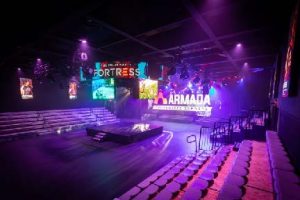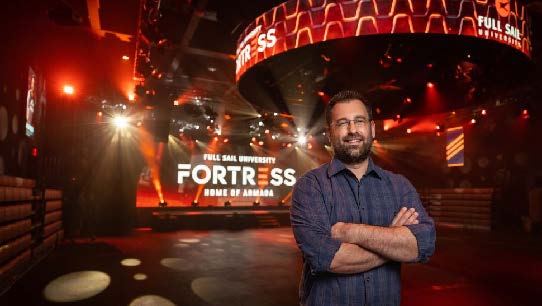Thousands of people across the country sit transfixed on their screens as the star player makes one last effort to lead his team to victory. Then, in an instant, the packed arena erupts with exuberant lights and music and the students in the bleachers go wild. The hero of the night stands up from behind his computer and acknowledges the crowd.
With all the bells and whistles of a top-tier sporting venue, The Fortress, Full Sail University’s new competitive video gaming arena, provides an esports experience unmatched by any college. Located on the university’s Winter Park, FL campus, this 11,200-square-foot, 500-seat space is packed with massive LED displays, concert -level lighting and sound systems, and the capability to stream out feeds of the action to audiences around the world. And overseeing all of this technology is Vince Lepore, Full Sail’s director of event technical operations.
“The experience of watching esports in the Fortress as a spectator is second to none, but our students get to experience these events from behind the scenes, working with industry professionals to produce every aspect of the event,” Lepore said. “In that sense, the Fortress is one of the most unique esports environments on any college campus in the country.”
Envisioning the Space
One of the fastest-growing entertainment industries of the past few years, esports is taking the world by storm. With estimates of a global viewer base of more than 400 million and revenues expected to crack the $1 billion threshold this year, it’s a force the technology world can no longer afford to ignore. And among the college-age demographic, there are a few pastimes that match its draw – and this is especially true at Full Sail, a school with one of the most prominent video game design programs in the country.
Last year, the university set out to create a dedicated home for its competitive gaming team, know as the Armada. Lepor, who has been working at Full Sail for close to 15 years – including as a course director teaching audio, video, and lighting design and show production – was involved in the project from the outset.
“I was involved from day one and all the way through the entire build-out,” he said. “I coordinated on the Full Sail side, alongside our internal design and technical teams, all of the design and installation of the audiovisual technology and the lighting.” According to Lepore, there were a few challenges to begin with. First the venue was being constructed within the walls of an existing building that formerly served as a sound stage. Second, despite its purpose as a gaming arena, the facility still needed to accommodate a variety of configurations needed for the various esports events that it was designed to host.
“We knew from the outset that the building needed to be as flexible as possible,” Lepore said. “This has really proven to be true for us because of the varied nature of all the esports events that we do: some of them are 1v1, some of them we do in the round.”
Lepore said that a lot of visitors remark that the room resembles a black box theater. “And in a lot of ways it is; all of or staging is portable and can be reconfigured for various staging needs,” he said. “We put a lot of time and effort into the structure so that we could rig trusses, LED walls, and lighting in a wide variety of configurations.”
Selecting the Tech
Working with Lepore, Full Sail staff, and the integration firm Pro Sound and Video, Full Sail outfitted The Fortress with a battery of advanced AV and lighting systems. Giving every spectator a clear view of the action in some 10 million pixels’ worth of direct-view LED panels. The most prominent of these are the 36-foot-wide by 11.5-foot-tall main displays at the back wall and a 24-foot-diameter center-hung LED ring.
“When you walk into the space, the LED screens are really the visual centerpiece, they grab your eye right away,” Lepore said. “There’s a lot of lighting, but the LED walls are really the most important part. For watching gameplay, that incredibly important, and we spent a lot of time making sure that every seat in the house would be able to see gameplay properly – no obstructions, no lights hanging in the LED walls, things like that.” Lepore said this wasn’t without its challenges, given the limited trim height of the existing building.
One noteworthy aspect of these displays in their uniformity; each one is composed of Absen PL2.9 2.9mm pixel pitch tiles. “Every LED tile in the space is identical – it’s all the same product,” Lepore said. “we’ve got hundreds and hundreds of PL2.9 tiles. So, from a maintenance perspective and an operational perspective, all of the LED product is identical, so we don’t have different pixel pitches, we don’t have different manufacturers or products – it’s all the same stuff.”
To drive the LED displays, Lepore chose Green Hippo Karst+ Hippotizer media servers. “We’ve been using Hippos for as long as I can remember here at Full Sail, so it’s something we know is industry-standard technology that we’re well versed in using,” he said. “we use them on live shows for both internal and external clients.”

Between the servers and the displays is a Barco S3 processor. “Every pixel in the facility runs through the Barco on its way out to the LED wall processors, and that allows us to manage picture-in-picture windows anywhere in the space, so that’s an important part of our workflow.” Lepore said. Operation of the video is done through Ross Video equipment and software, including a 3M/E Carbonite Black production switcher and Xpression graphics.
For audio, The Fortress employs L-Acoustics Kiva II line arrays, as well as X12 speakers and SB15 subwoofers. An eight-channel Shure wireless system handles miking needs throughout the space. All of the audio systems run over a Dante network.
Read MoreArticle credit: By
Image credit: Full Sail University
